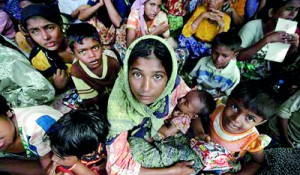Sunday Times 2
Survivors of Myanmar’s sectarian violence relive ordeals
View(s):
People displaced by the recent violence in the Kyukphyu township sit together after arriving to Thaechaung refugee camp, outside of Sittwe (REUTERS)
SITTWE, Myanmar (Reuters) – Muslim survivors of six days of sectarian violence in western Myanmar spoke on Sunday of fleeing bullets and burning homes to escape on fishing boats after an attack by once-peaceable Rakhine neighbours.
The United Nations said 22,587 people had now been displaced after unrest between Muslim Rohingyas and Buddhist Rakhines claimed at least 84 lives i n Rakhine State and tested the reformist mettle of the quasi-civilian government that replaced Myanmar’s oppressive ruling junta last year.
“We were told to stay in our homes but then they were set on fire,” said Ashra Banu, 33, a mother of four who fled the coastal town of Kyaukpyu after its Muslim quarter was razed on Oct. 24.
“When we ran out people were being shot at by Rakhines and police,” she said. “We couldn’t put out the fires. We just tried to run.”
New York-based Human Rights Watch earlier released before-and-after satellite images showing the near total devastation of the Kyaukpyu’s Muslim quarter.
Located about 120 km (75 miles) south of the Rakhine State capital Sittwe, Kyaukpyu is crucial to China’s most strategic investment in Myanmar: twin pipelines that will carry oil and natural gas from the Bay of Bengal to China’s energy-hungry western provinces.
No new clashes were reported on Sunday, but a Reuters journalist at Te Chaung camp near Sittwe witnessed a constant trickle of new  arrivals, mainly from Kyaukpyu, where more than 811 buildings and houseboats were destroyed according to Human Rights Watch’s analysis of satellite imagery.
arrivals, mainly from Kyaukpyu, where more than 811 buildings and houseboats were destroyed according to Human Rights Watch’s analysis of satellite imagery.
“The Rakhines came to attack us with knives. They set fire to our homes, even though we have nothing there for them. I left with only the clothes I am wearing,” wept a 63-year-old woman who said her name was Zomillah, as she sat on a crowded space in Te Chaung camp. “I can’t go back.”
The government estimates nearly 3,000 homes have been destroyed across in Rakhine State since Oct. 21. On Sunday, state television said the number of dead had risen to 84 from 67, but rights groups say the casualties are likely far higher.
Abdul Awal, 30, said police stood by as Rakhines burned their homes. “The Rakhines beat us, and the police shot at us. We ran to the sea and they followed us, beating us and shooting at us,” he said. “I have to start a new life now.”
A Buddhist Rakhine in Kyaukpyu tells a different story. Contacted by telephone by Reuters, he said Rakhines and Muslims had fought each other with knives, swords, sticks and slingshots. Overwhelmed, the Muslims then “set fire to their own houses as a last resort and ran away,” he said. The resident estimates 80 to 100 Muslim boats left Kyaukpyu that day.
“Many People killed”
Barefoot Muslim men and women alighted from engine-less fishing boats and climbed the muddy embankment to Te Chaung camp carrying children and what meagre possessions they had salvaged from the inferno.
“I saw many people killed,” said Noru Hussein, 54, another ex-resident of Kyaukpyu. “We didn’t fight back. How could we? We live in a place surrounded by Rakhine villages. We just fled to the beach and escaped by boat.”
Te Chaung camp was created after a previous explosion of sectarian violence in June killed more than 80 people and displaced at least 75,000 in the same region. Already squalid and overcrowded, the camp was ill-equipped to cope with more inhabitants.
Forty-seven boats carrying 1,945 Rohingya men, women and children have landed at villages near Sittwe in the past few days, said a local official, who requested anonymity.
Myanmar’s Buddhist-majority government regards the estimated 800,000 Rohingyas in the country as illegal immigrants from Bangladesh and denies them citizenship. Bangladesh has refused to grant Rohingyas refugee status since 1992. The United Nations calls them “virtually friendless”.
People at Te Chaung said many more boats full of Rohingya had left Kyaukpyu but had yet to reach land.
The camp lies on a remote coast at the end of a pot-holed road from Sittwe. Its tents and two-story huts are linked by muddy lanes and guarded by about a dozen unarmed officials.
The only obvious aid consists of sacks of rice from the World Food Program. The empty sacks double as sleeping mats. Many people bed down beneath trees.
Reuters saw no medical workers. Some of the camp’s inhabitants suffer from malaria. The children are naked and often malnourished.
Mohammed Jikeh, 34, a former fishseller, has lived here since the June violence, which he said claimed the lives of 11 relatives.
“We have no hope,” he said. “We want this violence to stop. We want to live in peace. But like this none of us can survive.”
Follow @timesonlinelk
comments powered by Disqus























